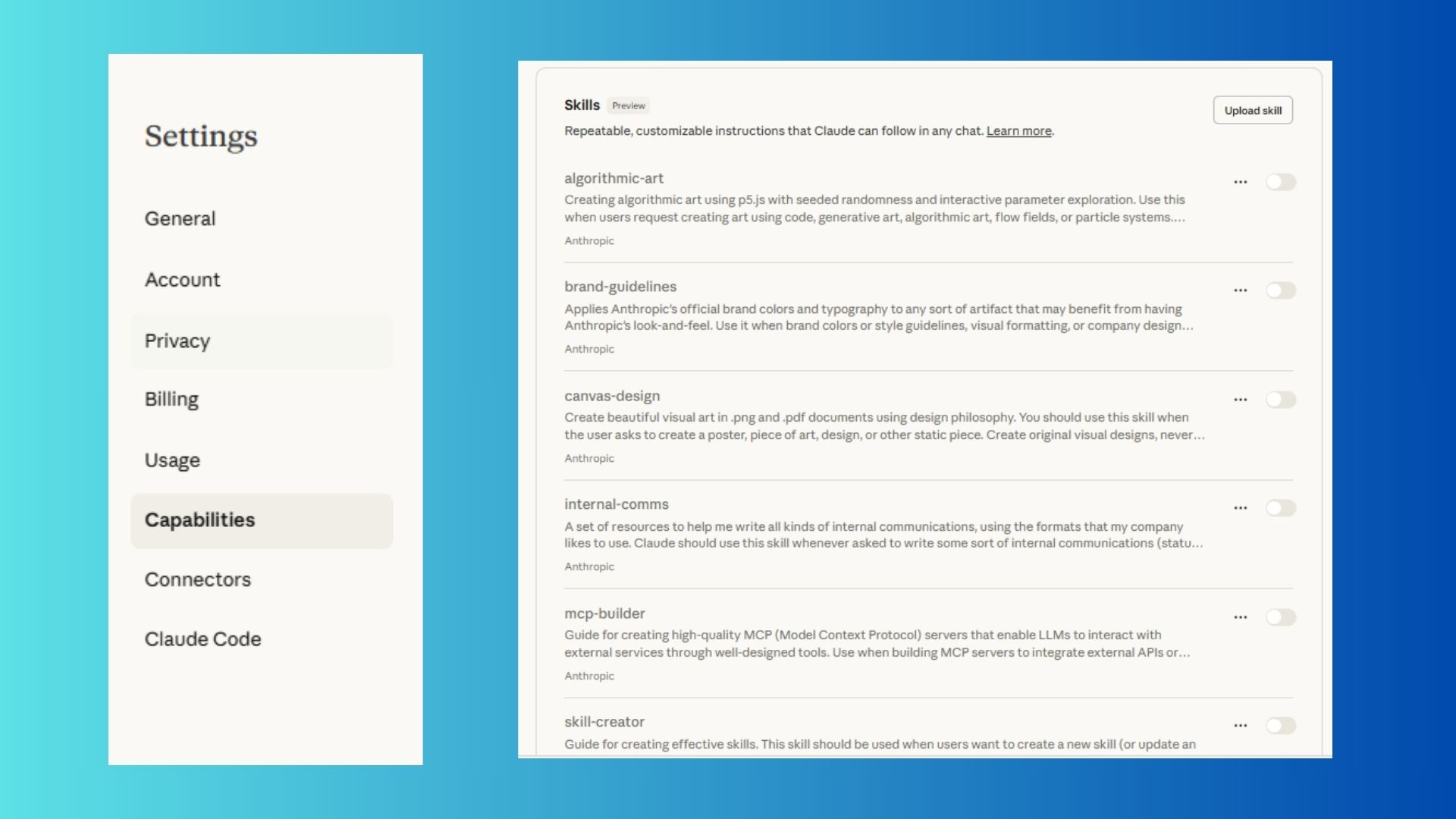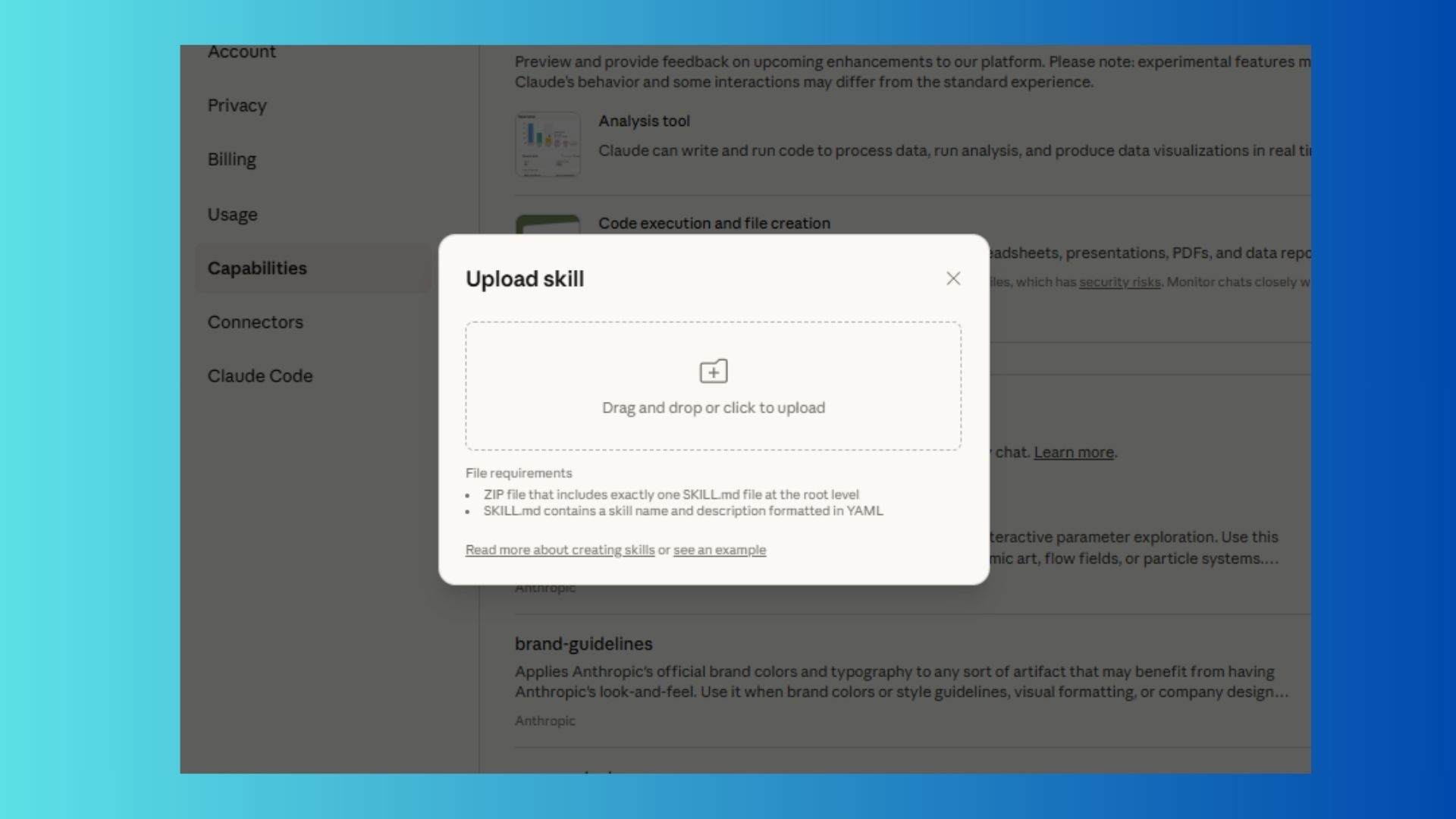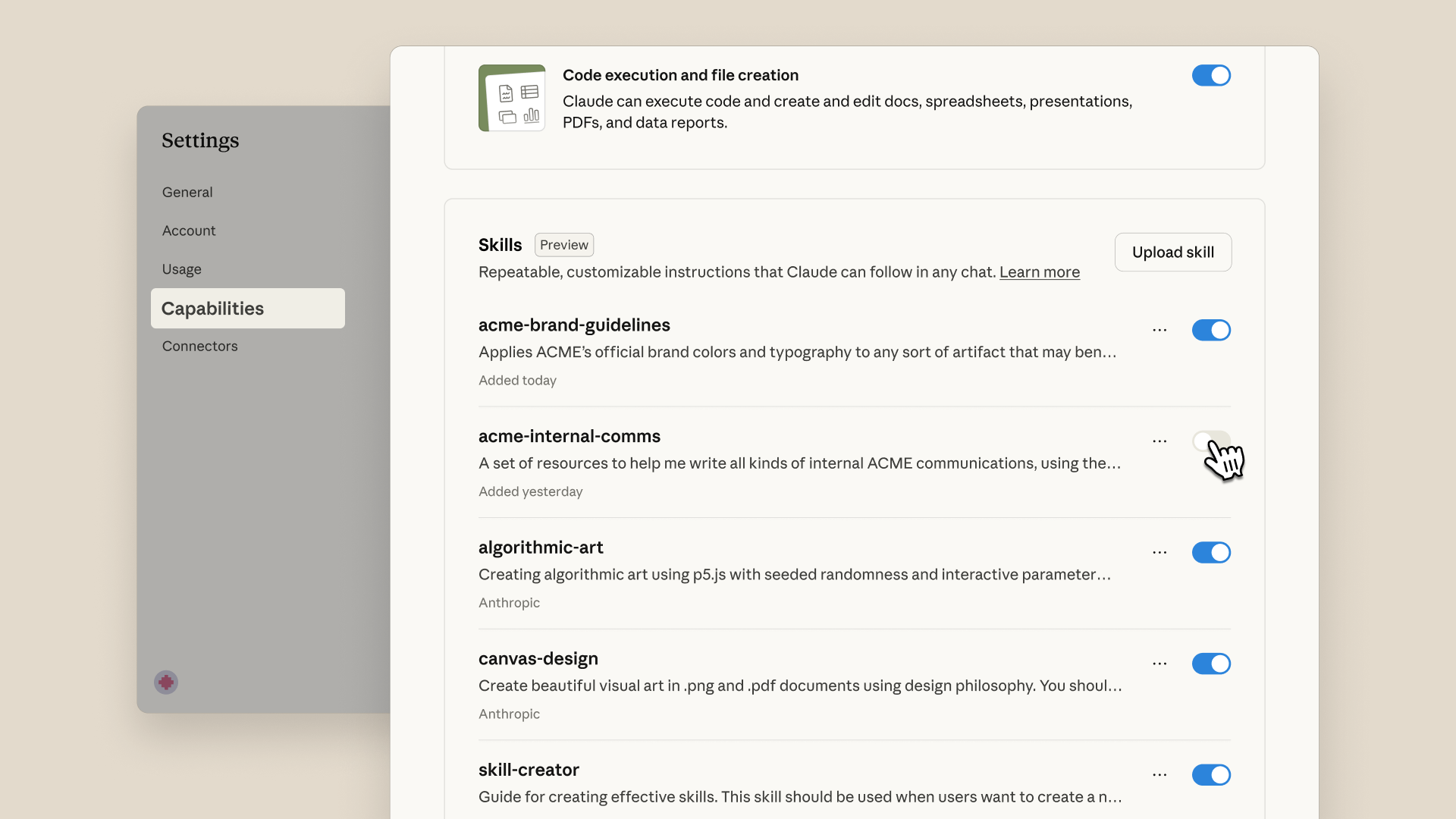Claude Skills are here — and they might be the smartest AI feature you’re not using yet

Claude is already one of the smartest AI assistants around, but with the release of Sonnet 4.5 and Haiku 4.5, both packed with upgraded reasoning and creativity, I was especially eager to test what they could do with Claude Skills. These new modular tools are baked right into the platform and promise to supercharge productivity by automating workflows, applying custom logic, and delivering smarter, faster results with less prompting.
More than Gemini Gems or Custom GPTs, the Skills are like mini assistants for your projects. I recently switched from ChatGPT Plus to Claude Pro, which has allowed me to give the lightweight yet mighty feature a try. Skills are limited to certain user tiers (Pro, Max, Team, Enterprise) and are not yet available for free.
Here’s how to give Skills a try and add this new feature to your AI toolbox.
What are Claude Skills?
Claude Skills is a new feature from Anthropic that lets you create reusable, task-specific instructions for Claude. Instead of repeating the same prompt every time you need help writing a press release or applying your company’s style guide (for example), you can build a Skill that Claude automatically activates whenever it detects the right context.
Each Skill includes:
- A name and description that tells Claude when to use it
- A Skill.md file with step-by-step instructions, formatting, rules and examples
- Optional extra files, like brand assets, templates or scripts
- The ability to trigger automatically — without you saying, “Use this skill.”
And unlike long, complex prompt chains, Skills are modular and organized, which means they are easy to update, share and repurpose.
How to make a Claude Skill (it’s easier than you think)

To get started on claude.ai, go to Settings and make sure ‘Skills’ is enabled. There are several Skills to choose from, but you can easily create a Skill; all you need is a text editor, a plan and a ZIP file. Here’s the basic setup I used:
1. Start with a folder
Create a new folder on your computer. This will hold your Skill.md file and anything else you want Claude to reference, like PDFs or logos.
Get instant access to breaking news, the hottest reviews, great deals and helpful tips.
2. Add your Skill.md file
This Markdown file is the heart of your Skill. It should start with metadata like this:
Name: Client Proposal Formatter
Description: Format client proposals in our house style with headers, logos, and signature blocks
Version: 1.0.0 (not completely necessary, but if you’re planning to update your brand guidelines or projects, you’re going to want to include the version number).
Underneath is where you’ll write your instructions. This is kind of like a mini user manual for Claude, so I recommend including things like tone of voice, required sections, sample layouts and do’s/don’ts. Basically a prompt, but with extra details. Be as specific as possible here; remember, you’ll only be doing this once, not prompting every time.
3. Add any reference materials
You’re going to want to beef up Claude’s knowledge within the Skill by including important reference materials. If you want Claude to include specific files or follow a visual style, then add those directly to your folder. For example, add your latest brand guidelines deck and a couple of sample proposals. Claude will learn based on these sources. You could even add a Google Mixboard for visuals.
4. Zip it up and upload to Claude
Compress the folder, upload it under Claude’s Skills settings, and toggle it on. From there, Claude will use it when it makes sense. You won’t even need to prompt it. This was truly mind-blowing when I saw it in action.
What it’s like to actually use a Skill

Here’s where it gets cool. Once a Skill is enabled, Claude will detect when it’s relevant, based on all the references you uploaded to your file.
So instead of pasting in an entire style guide every time you want to create a new proposal or write a client email, Claude understands the context and actually gets it. Your custom Brand Voice Skill will kick in, so you stay on-brand with all your copy.
Better yet, Claude showed me what Skills it used in the sidebar (called the “thinking trace”), just so you can double-check or adjust. Even though you can set it and forget it, I appreciate the transparency of seeing the trail of Skills.
My favorite Skills so far

The possibilities are really endless in terms of the Skills you compile for Claude. But here are three Skills I’ve built that blew me away:
Weekly newsletter formatter: Turns messy bullet points into a clean, engaging newsletter with headlines, emojis and CTAs. This has leveled up my Substack profile by getting a professional newsletter out the door.
Slide deck brand styler: You can apply fonts, colors and logos to a presentation draft.
Press release generator: Writes PR drafts in AP style based on key product details. If you are a publicist, brand or small business, you’re going to want to try this one.
The best part is that each one took maybe 10–15 minutes to set up. And, although the first two are the only ones I’ve used (the third was just to see what Claude could do), they’ve already saved me hours of repetition.
Tips for building better Claude Skills
If you’re technical, you can also include lightweight scripts (like Python or Node.js) inside your Skill folder for things like data transformations or formatting. But even non-coders can build powerful workflows with no trouble.
Here’s what I’ve learned from tinkering:
- Keep each Skill focused on one job. This is not the time to multitask Skills.
- Make your description clear — Claude relies on it to trigger the Skill
Include sample inputs and outputs in the Skill.md file (that’s just the fancy name for the file you upload to Claude). - Create versions of your Skills — so you can tweak and improve over time
- Watch the “Skills used” trace in Claude to see what’s firing
Final thoughts
When Claude Skills first launched, I wasn’t sure if I would have any use for them. I think that’s true a lot of the time for new chatbot features. Users may see a chatbot like Claude as a one-trick pony, but Anthropic is constantly updating the models and adding features for real-world tasks that can be used for just about anyone — professionals and casual users alike. And, since the tools are so easy to use and require little to no coding, I highly recommend giving them a try.
Whether you're managing social media calendars, formatting reports, or just want better answers faster, Skills is the upgrade you didn’t know you needed.
Follow Tom's Guide on Google News and add us as a preferred source to get our up-to-date news, analysis, and reviews in your feeds. Make sure to click the Follow button!
More from Tom's Guide
- I don't want my child sexting with ChatGPT — here's why I'm switching my family to Claude
- I tested ChatGPT-5 vs. Claude Haiku 4.5 with 7 challenging prompts — and there's a clear winner
- Gemini 3.0 Pro might already be here — what we know so far

Amanda Caswell is an award-winning journalist, bestselling YA author, and one of today’s leading voices in AI and technology. A celebrated contributor to various news outlets, her sharp insights and relatable storytelling have earned her a loyal readership. Amanda’s work has been recognized with prestigious honors, including outstanding contribution to media.
Known for her ability to bring clarity to even the most complex topics, Amanda seamlessly blends innovation and creativity, inspiring readers to embrace the power of AI and emerging technologies. As a certified prompt engineer, she continues to push the boundaries of how humans and AI can work together.
Beyond her journalism career, Amanda is a long-distance runner and mom of three. She lives in New Jersey.
You must confirm your public display name before commenting
Please logout and then login again, you will then be prompted to enter your display name.











